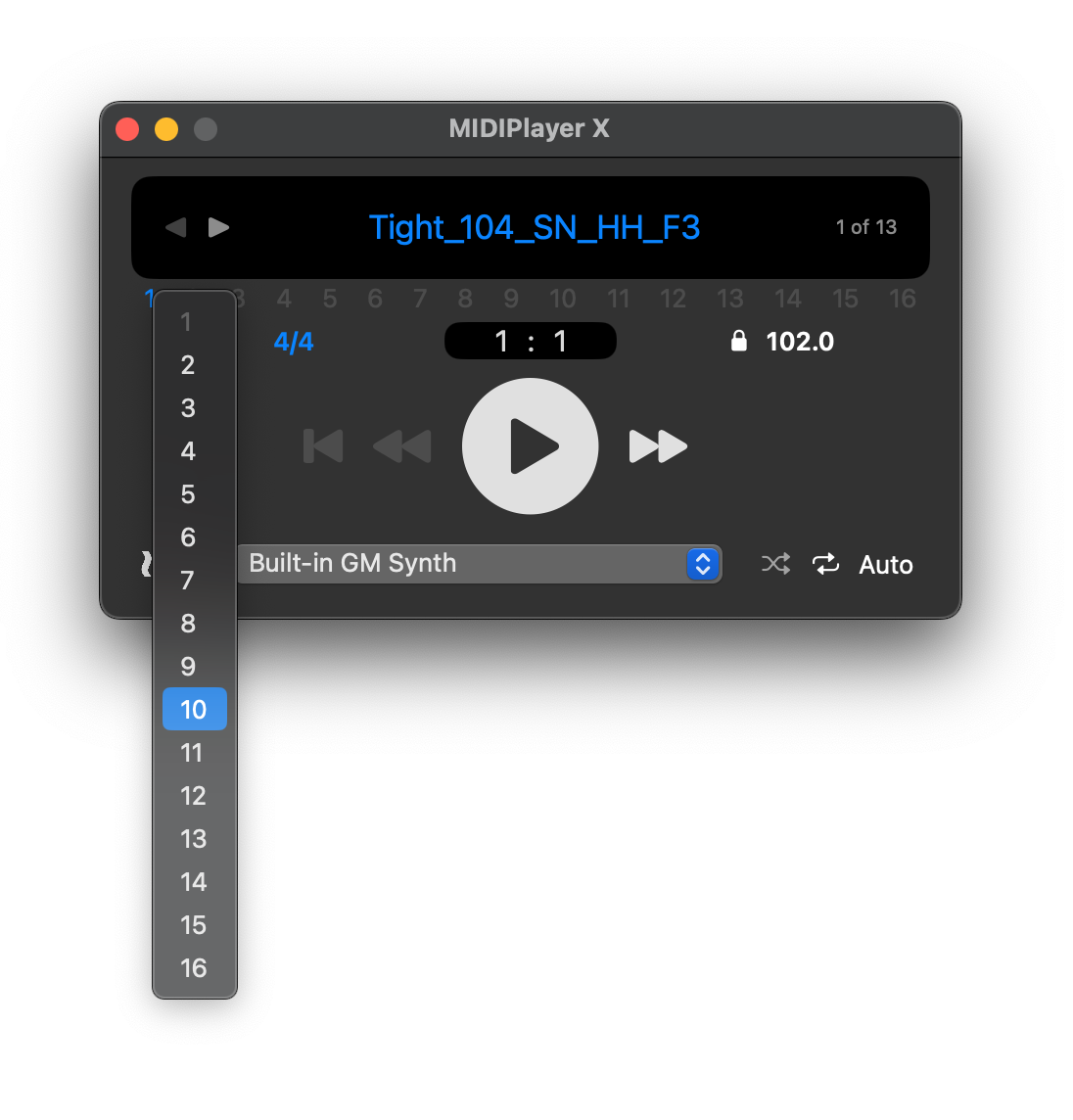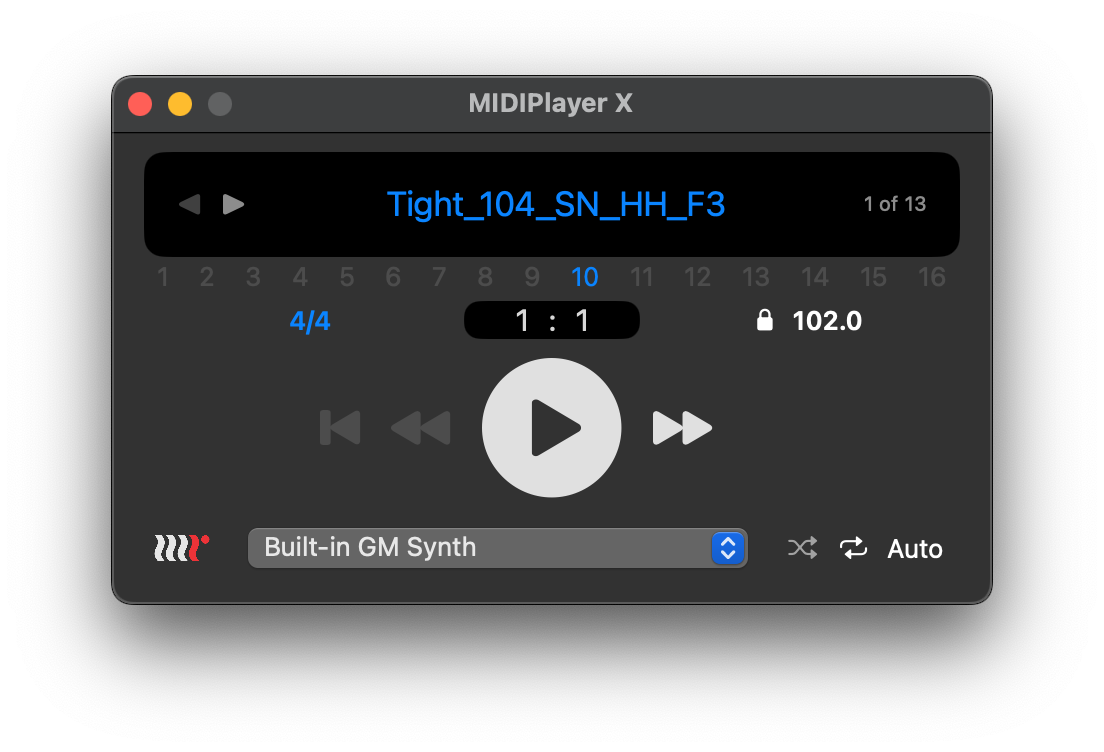MIDIPlayer X
QuickStart
v3.1
Installation
If you purchased MIDIPlayer X through the Mac App Store, it will be installed in your Applications folder.
Loading MIDI Files
Load MIDI files into MIDIPlayer X using several Mac friendly methods:
- Drag and drop a MIDI file, files, and/or folders containing MIDI files onto MIDIPlayer X’s window.
- Drag and drop a single MIDI file, or single folder containing MIDI files onto MIDIPlayer X’s Dock icon.
- Use the standard File>Open or File>Open Recent menu options.
- Use the Finder’s Open With command by control-clicking on a MIDI file and selecting MIDIPlayer X from the Open With menu.
When using drag and drop, MIDIPlayer X’s window frame will highlight when a MIDI file is dragged into the window.
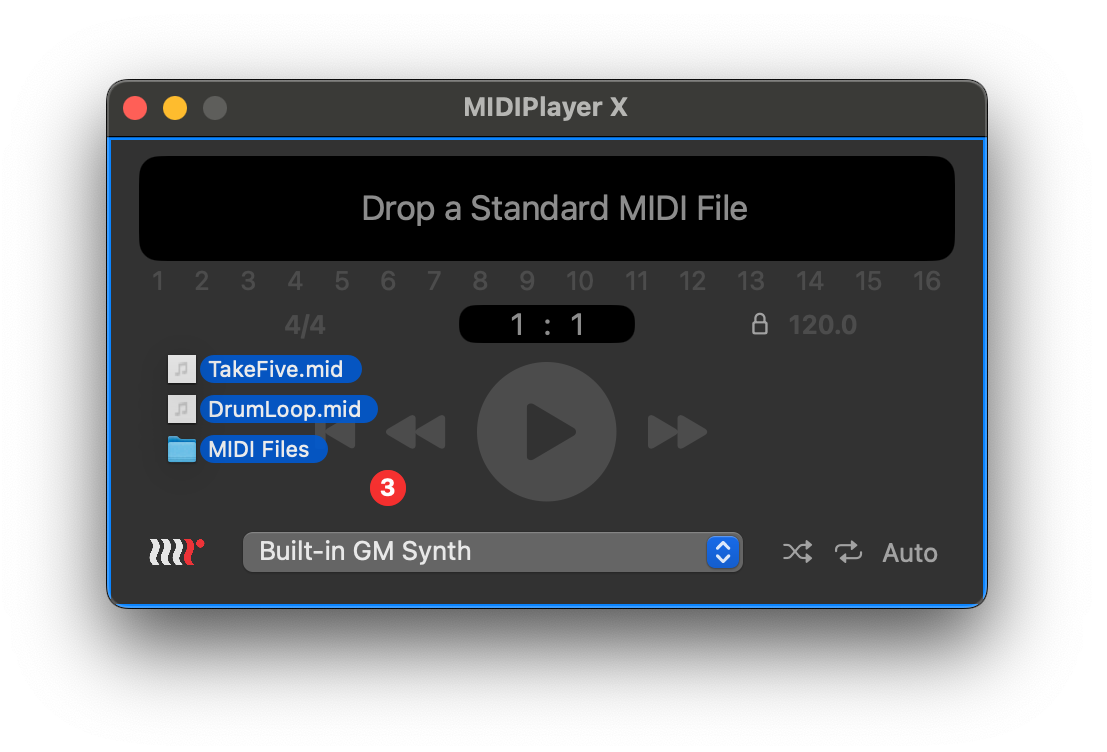

Display
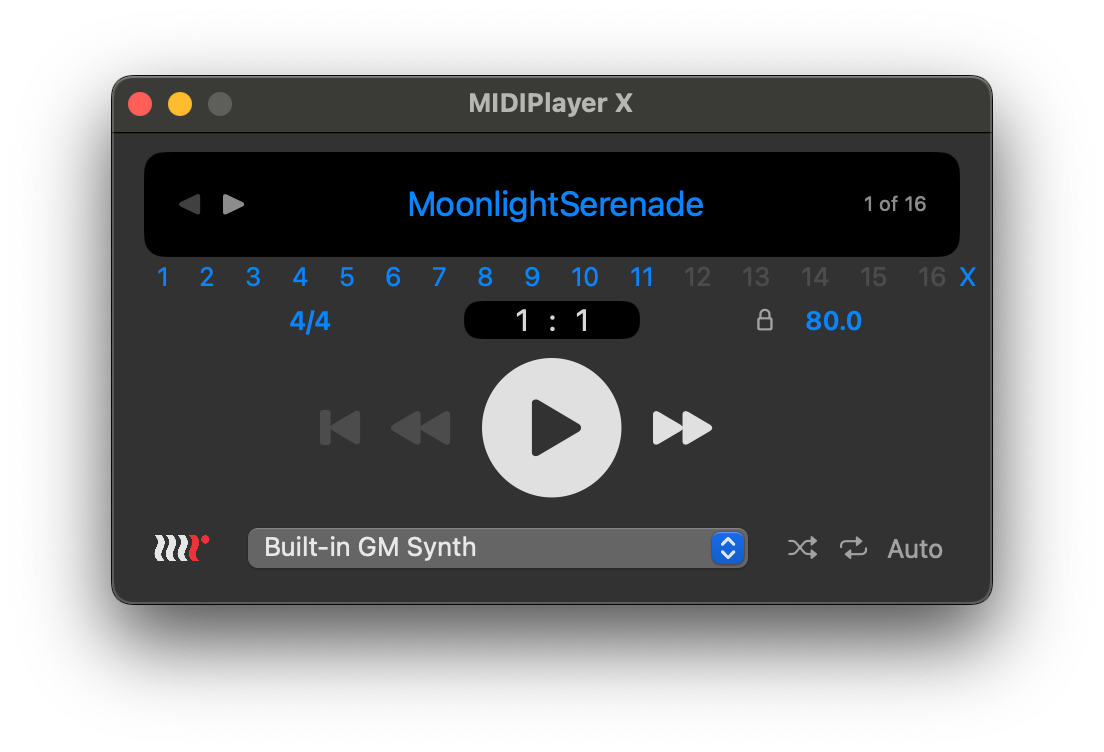

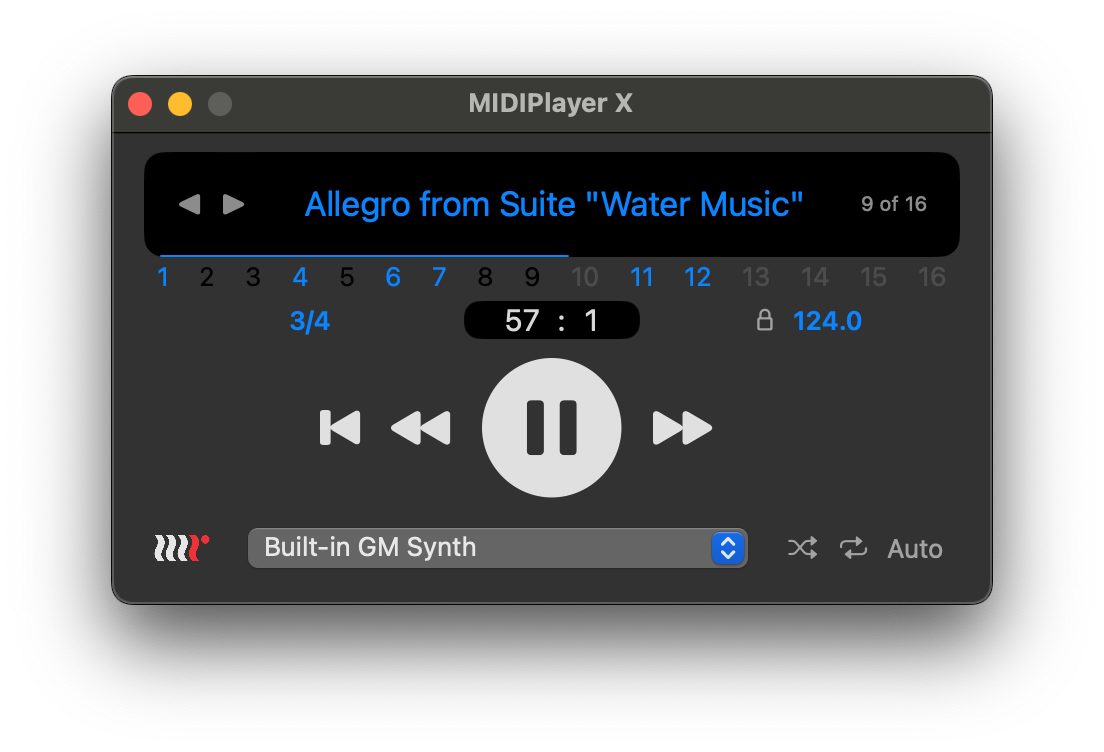

Once a file is loaded, MIDIPlayer X will display several types of information:
- The MIDI file’s title, if the creator included one; or its filename if not.
- If multiple files are loaded:
- Previous / Next file buttons will show left of the title
- Current and total file count will show right of the title
- MIDI channels present in the file will be highlighted by the 16 numbered channel buttons under the title. Blue indicates that channel is present in the file; grey indicates the channel is not used in the file.
- System Exclusive message are represented by the “X” to the right of 16. This will flash during playback if/when a SysEx message is sent by the file.
- The file’s time signature and tempo. These will update if the file includes changes.
- Tempo Lock icon, off by default.
- The counter will be set at bar 1, beat 1.
- The currently selected MIDI Output to which the file will play.
- Shuffle mode, off by default.
- Loop status, off by default.
- AutoPlay status, off by default.
Timeline
- Once playback begins, the file’s progress will be indicated by the blue line below the title.
- Click and/or drag in the black header view to jump to any point in the file.
Display Options
Show Title | Filename (option-N)
Use the File>Show Title|Filename menu item or key command to toggle the displayed title or filename:
- Show Title: the file title, if provided by the file’s creator; the filename if not. Title is the default setting.
- Show Filename: show’s the filename on disk.
- Your Title | Filename preference will be recalled the next time you launch MIDIPlayer X.
Counter Format (option-C)
Select the Controls>Counter menu option or key command to change the counter format; or simply click the counter to toggle its format:
- bar : beat: Displays elapsed time as standard bars and beats.
- min : sec: Displays elapsed time as minutes and seconds.
- Your Counter format will be recalled the next time you launch MIDIPlayer X.
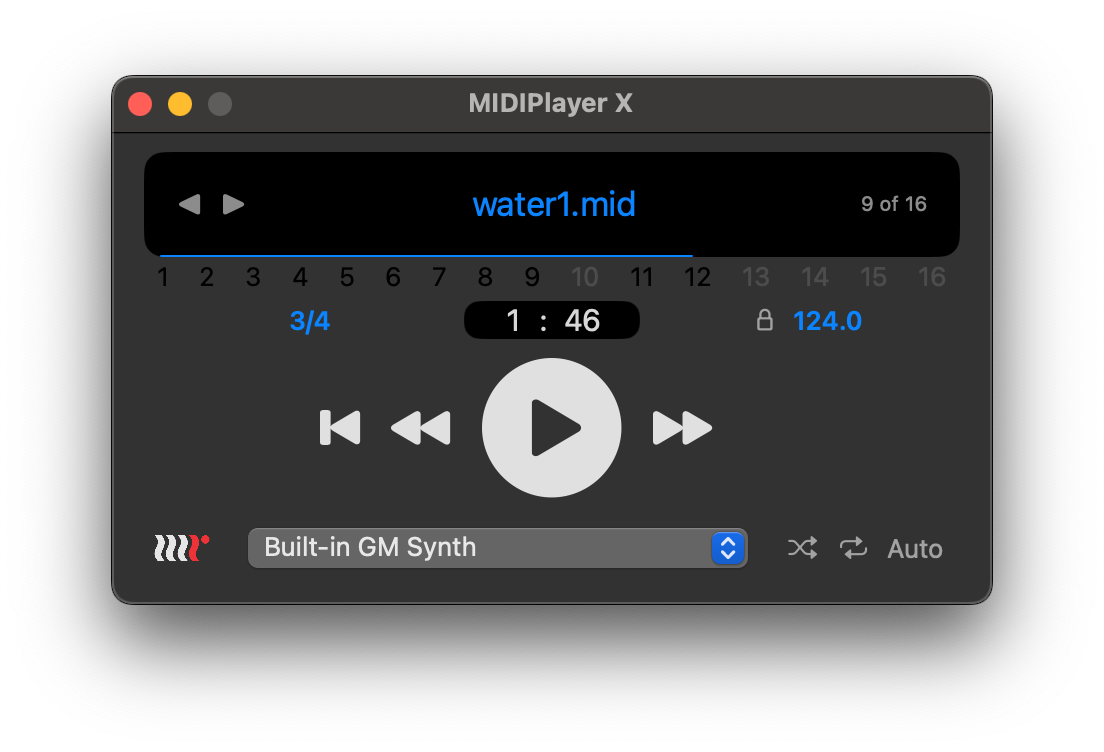

MIDI Outputs
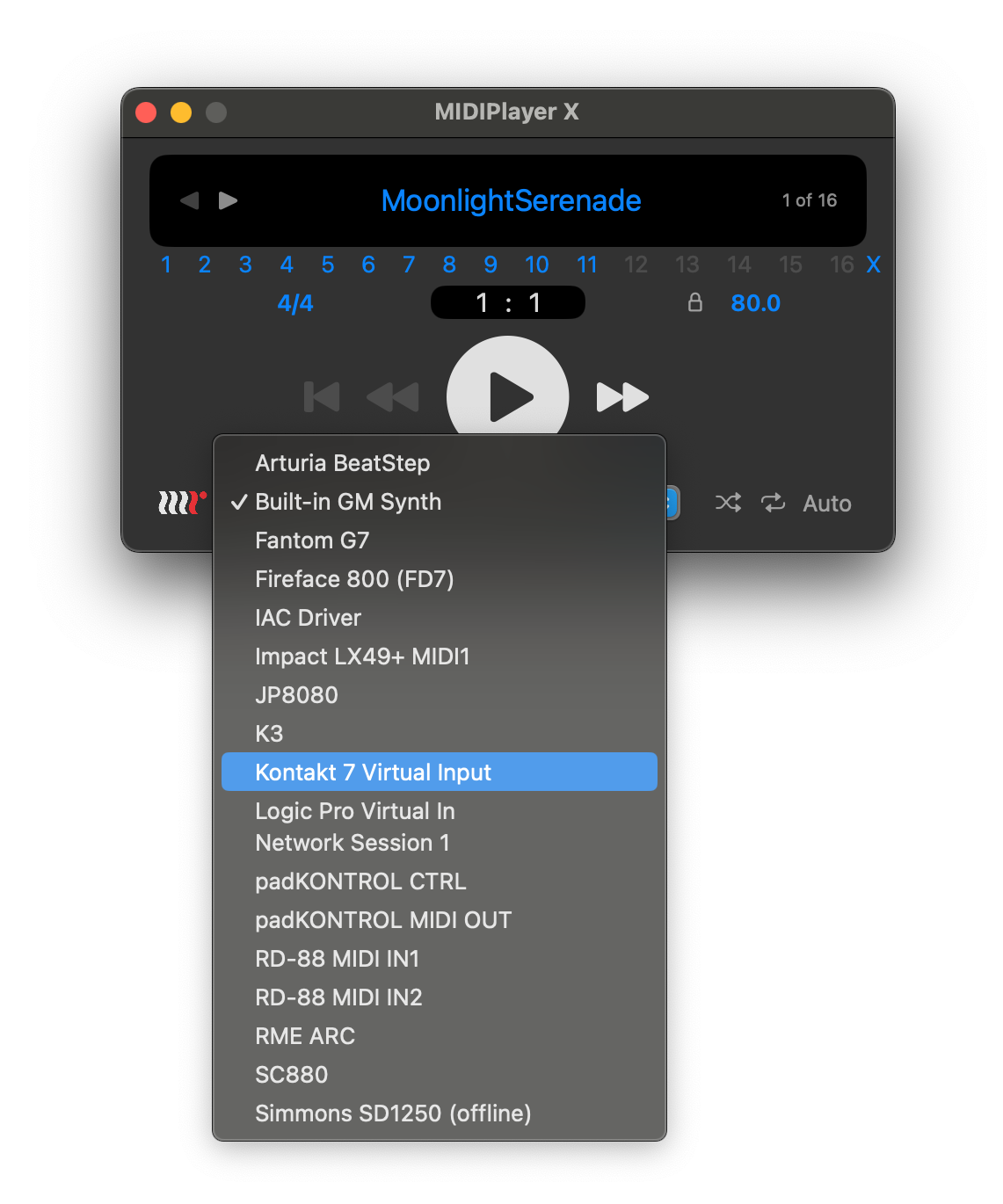

The MIDI Output menu will display all available MIDI outputs that the file can play to. These MIDI Outputs come from three sources:
- MIDI Hardware: As configured in your Mac’s Audio MIDI Setup (AMS) studio setup. The AMS utility is pre-installed on every Mac, and should be found in Applications/Utilities.
- MIDI Software: Some MIDI software may publish its own virtual MIDI input. Any such published virtual inputs created by other MIDI software will also appear in MIDIPlayer X’s output menu. Depending on the other software, their virtual input may be automatically visible, may need to be enabled in a preference setting, or may not be available at all. Apple also provides their IAC Driver (Inter Application Communication) in AMS to allow MIDI communication between software applications.
Built-in GM Synth: MIDIPlayer X also includes a General MIDI-compatible synthesizer using Apple’s CoreAudio technology.
Note: AMS remembers your hardware connections, so when disconnected or powered off, MIDIPlayer X will display the output as (offline). Virtual outputs created by software are not tracked by AMS, and will disappear from MIDIPlayer X’s menu if/when the other app is quit.
Transport Controls
Play | Pause (spacebar)
- Press the Play button to start playback; press it again to pause.
Rewind | FastForward (← | →)
- Press to move one measure in either direction. Can be pressed while playing or paused.
Reset (return)
- Returns the MIDI file to its beginning. Can be pressed while playing or paused.
AutoPlay (option-A)
AutoPlay has three modes indicated by the color of the AutoPlay button:
- Off (Light Gray): MIDIPlayer X waits for you to start playback with the Play button or key command.
- On (White): Playback begins immediately after the file is loaded or selected. When the current file reaches its end, it will stop and reset to the beginning.
- Advance (Blue): Playback begins immediately after the file is loaded or selected. When the current file reaches its end, MIDIPlayer X will advance to the next file and begin playing. When it reaches the end of the last file, it will loop around and begin playing the first file.
- Once paused, AutoPlay has no effect until the next file is loaded or selected.
- Your AutoPlay setting will be recalled the next time you launch MIDIPlayer X.
Loop (option-L)
When enabled, MIDIPlayer X will loop the file, playing repeatedly without end.
- Loop can be enabled before or after you load files.
- Your Loop setting will be recalled the next time you launch MIDIPlayer X.
Note: Loop and AutoAdvance are mutually exclusive: MIDIPlayer X cannot loop a file repeatedly AND also advance to the next file, so AutoAdvance is disabled when Loop is enabled. AutoPlay is still available when Looping files.
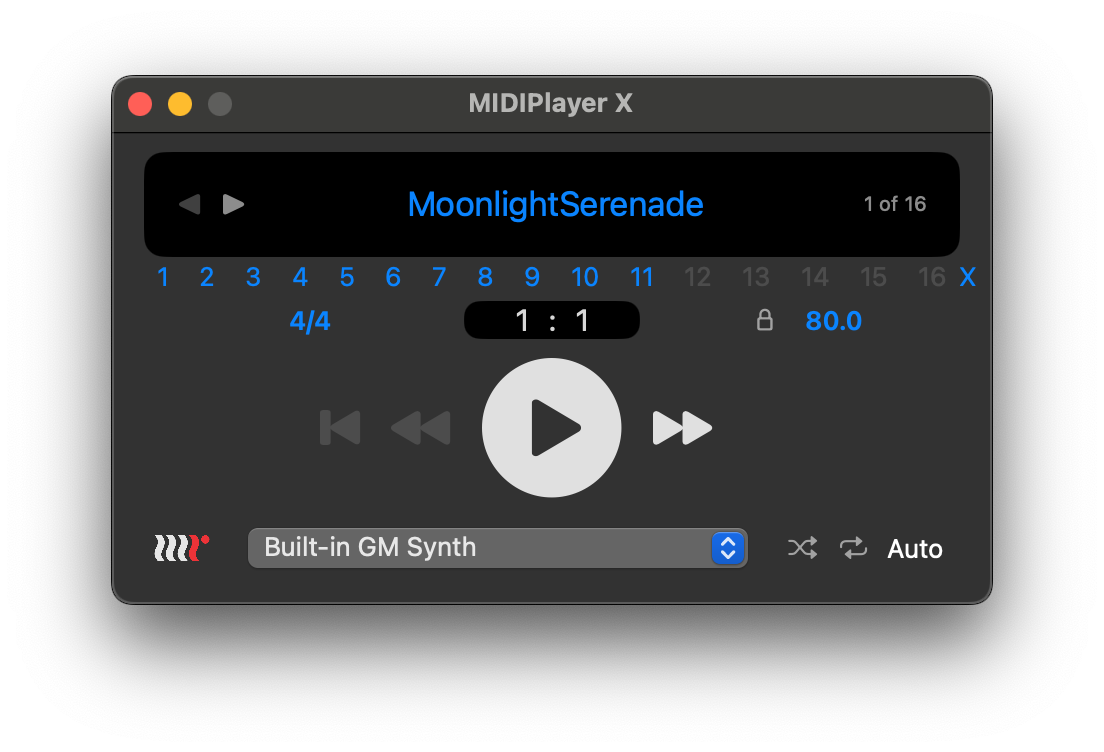

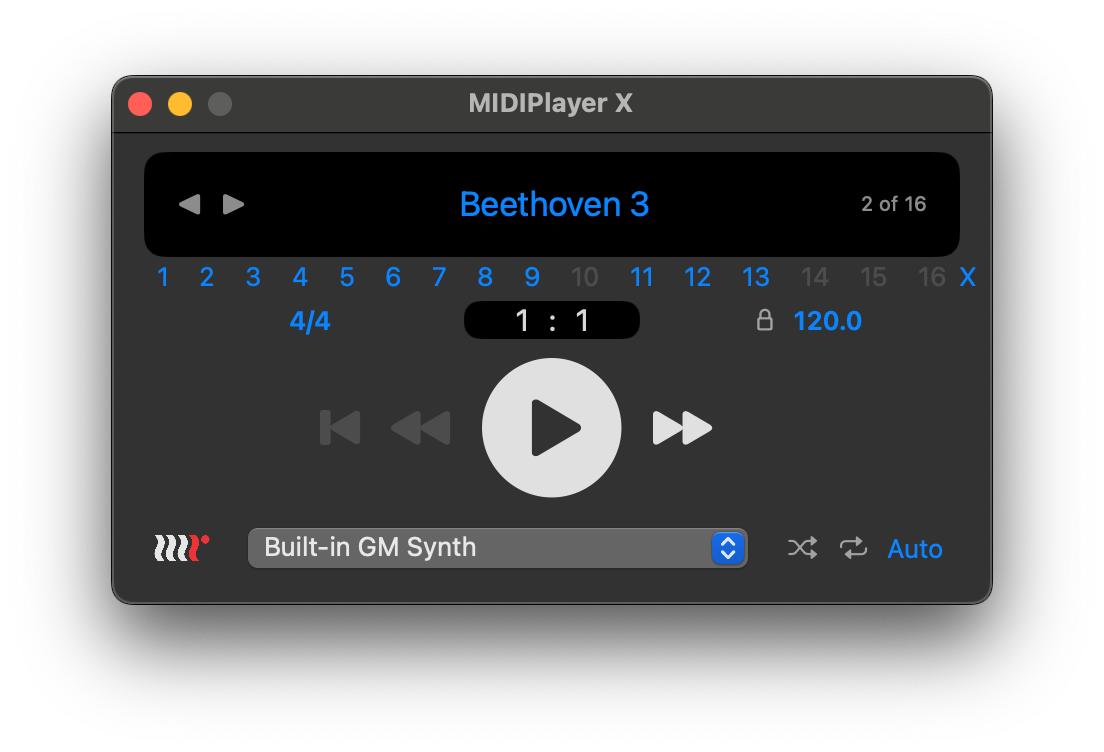

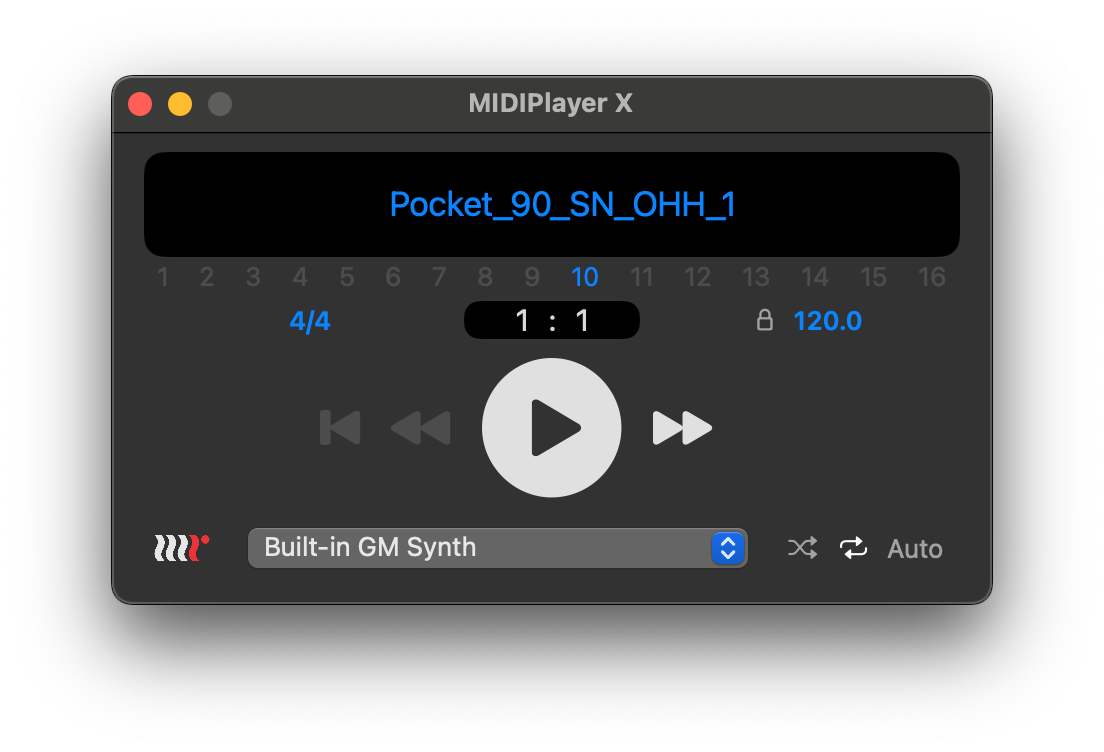

Selecting Files
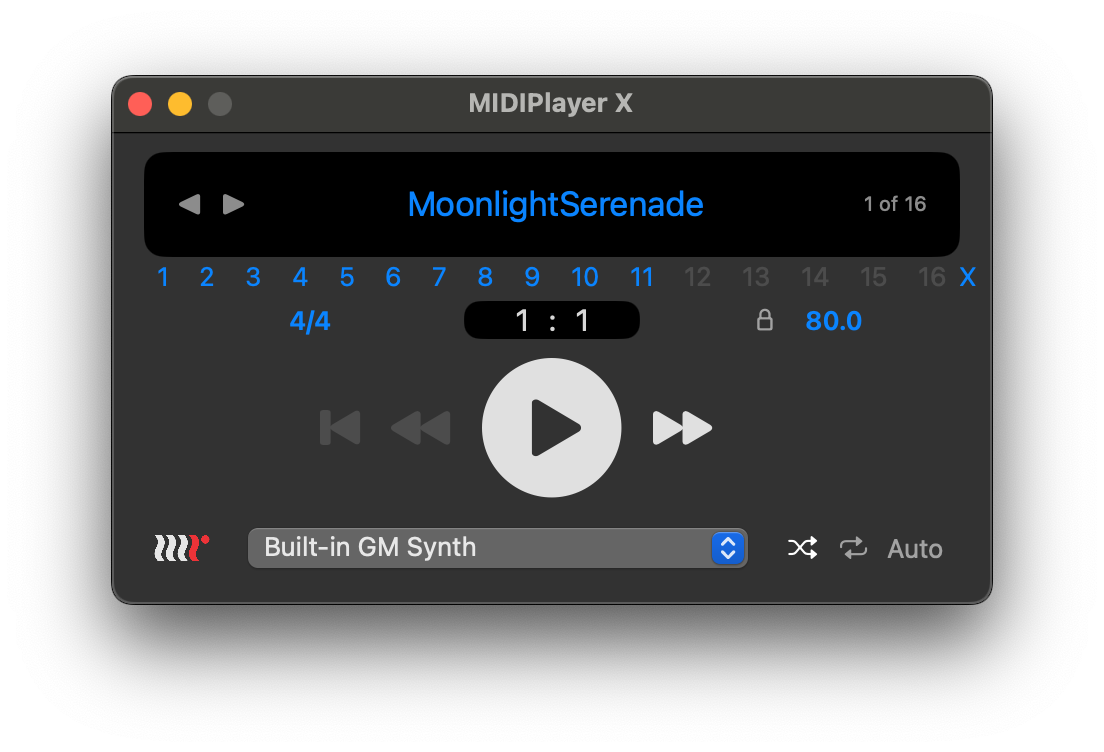

If multiple files have been loaded, you can cycle through your files using the Previous | Next buttons or key commands, and/or enable Shuffle to randomize playback order:
Previous | Next (command -[ ])
- Press the Previous or Next button to move to the previous or next file.
- If AutoPlay is on, the newly selected song will begin to play.
- If AutoAdvance is on, MIDIPlayer X will automatically select the next file after the current file ends.
Shuffle (command -\)
- Toggle the Shuffle button on/off as desired.
- When Shuffle is on, MIDIPlayer will make a random selection from the unselected files as the Next file.
- When all files have been selected/played:
- AutoAdvance Off: MIDIPlayer X will stop, Next will be disabled.
- AutoAdvance On: MIDIPlayer X will continue making random selections and AutoAdvance to its Next selection.
Delete Unload (delete)
- Press the Delete key to unload the selected file.
Tempo Controls
Tempo (↑ | ↓)
- Adjust the tempo up or down.
- Step through small changes, or simply hold the up or down key for larger changes.
- The tempo display will change from blue to white, indicating you have changed it from the file’s original tempo.
- Double click the tempo to reset it to the file’s original tempo.
- Tempo changes can be saved to a new file.
Note: MIDIPlayer X limits tempos to between 30 – 480 bpm.
Tempo Lock (option-L)
When Tempo Lock is enabled, MIDIPlayer X will play all files at the selected tempo, ignoring any tempo events within the file.
- Click the lock icon beside the tempo display to Lock Tempo.
- The lock and tempo will display as white indicating Tempo Lock is enabled and you are controlling the tempo.
- Click the lock icon off to restore the file’s original tempo map.
- Tempo Lock can be enabled before or after you load files.
Note: If you save a new file while Tempo Lock is enabled, the resulting file will have no tempo events, and play at the default 120 bpm.
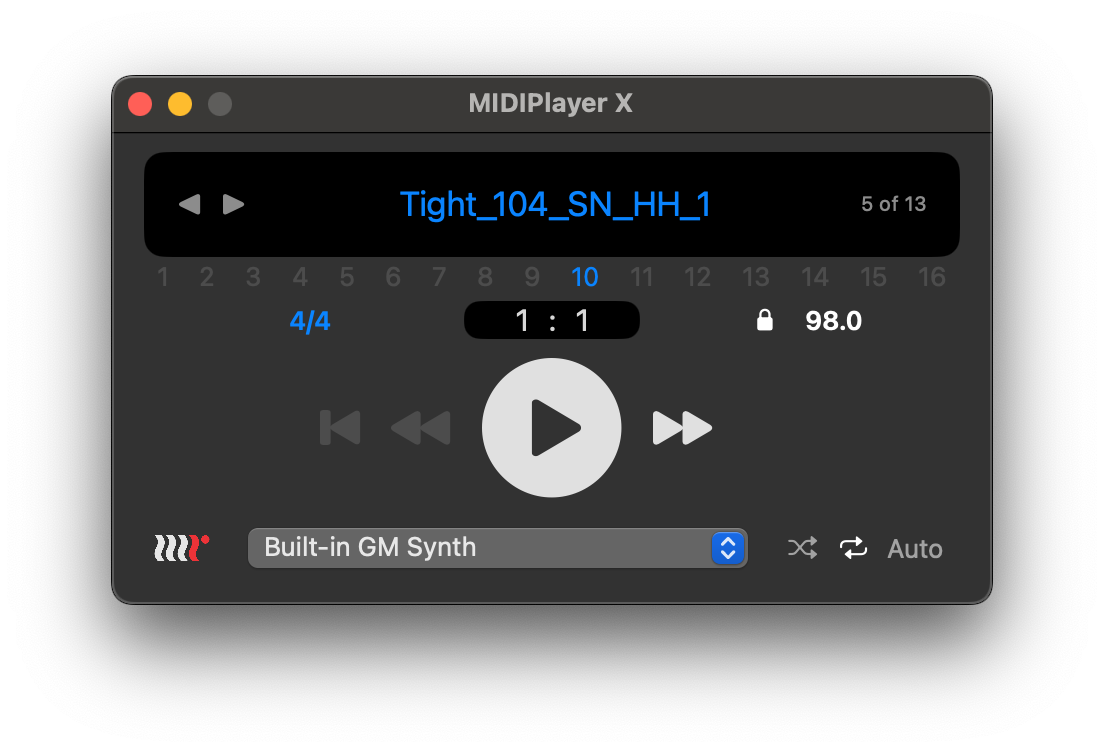

Transpose
Transpose ( shift + | shift -)
- Each key press will transpose +/- 1 semi-tone.
- All channels, except channel 10 (commonly used for drums), will be transposed.
- The white Tranposed indicator, as shown at far right, will be displayed when the file has been transposed from its original pitch. An in progress indicator may show temporarily while the tracks are being transposed.
- Double-click the Transposed indicator to reset the file to its original pitch.
- Transposed files can be saved to a new file.
Note: MIDIPlayerX limits transposition to +/- 12 semi-tones.
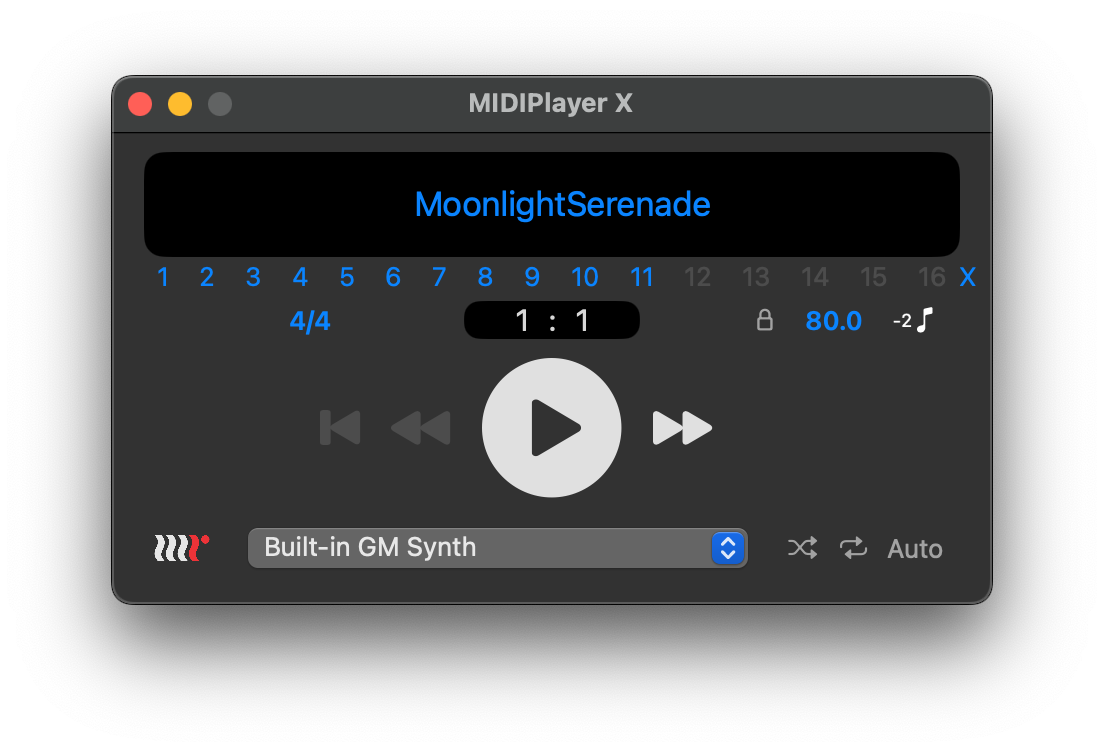

Mute and Solo Channels
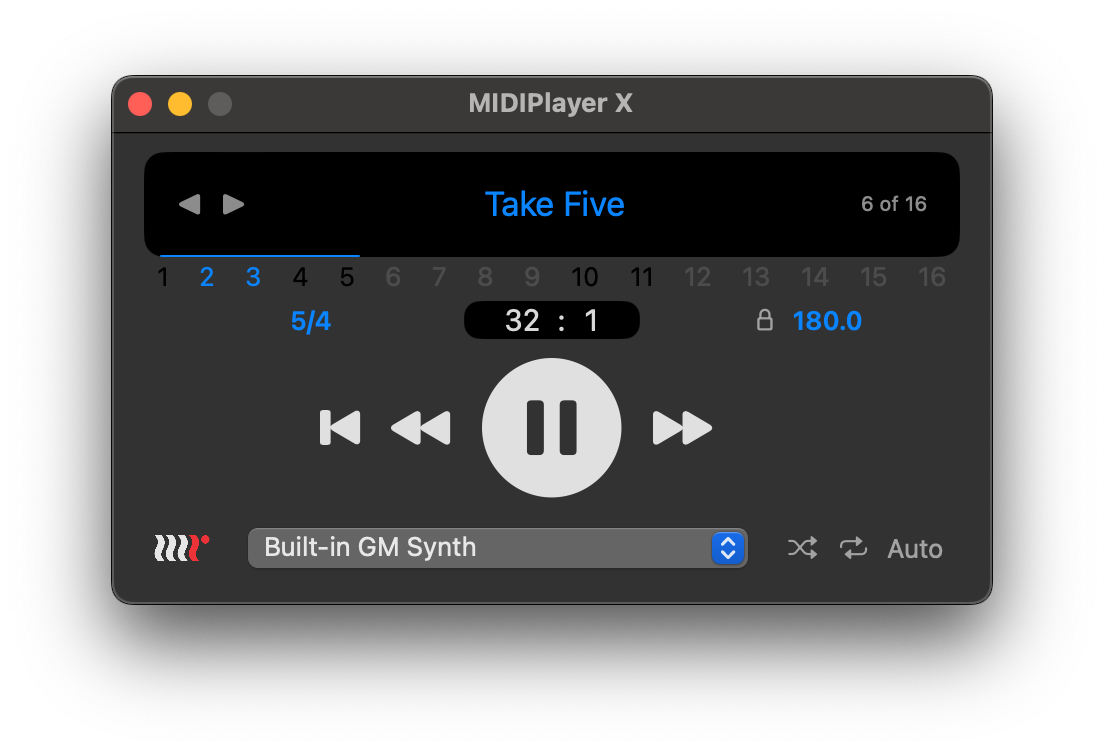

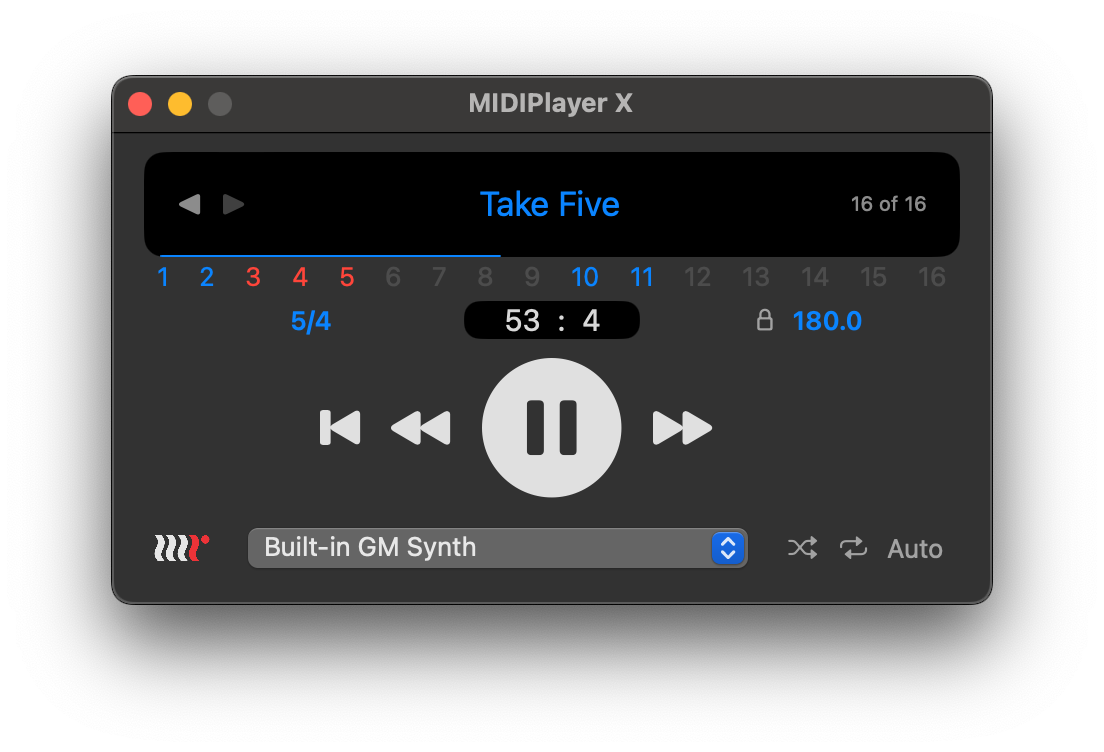

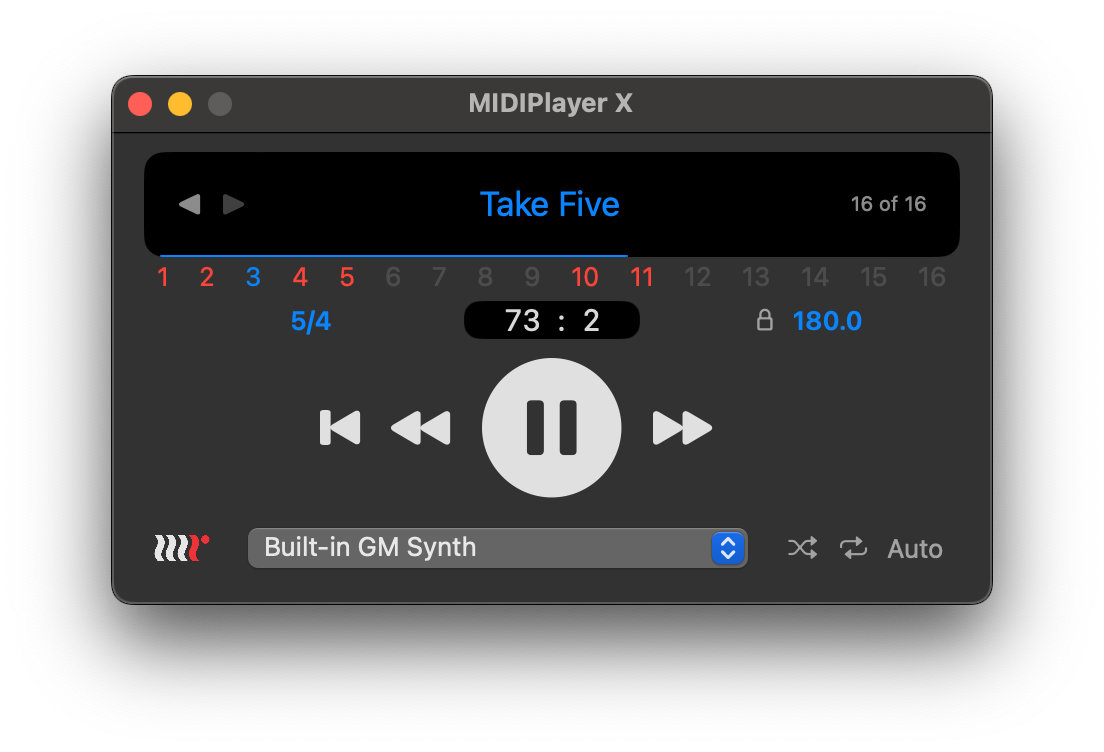

The channel indicators will show one of four colors reflecting their current state:
- Blue: channel has MIDI events and is active. This is the default state when:
- a file is first loaded, to provide a quick overview of the content.
- each time the file is reset to its beginning.
- Black: channel has MIDI events but not at the current song position. This is the normal state when the player is paused.
- Gray: the song does not contain MIDI events on this channel.
- Red: the channel is muted.
Mute
- Click on a channel number to mute that channel.
- Click the channel again to unmute it.
- You can mute multiple channels.
- Shift click on a channel to mute or unmute all channels.
Solo
- Option click a channel number to solo that channel.
- Option click the channel again to unsolo it.
- After soloing a channel, you can unmute other channels by clicking on them, as above.
Change MIDI Channels
Reassign MIDI channels within the file. For example, move drum pattern files from Channel 1 to Channel 10 to make use of the Built-in GM Synth kits.
Rechannelize
- Control click a channel number to display a list of MIDI channels.
- Select a channel from the list to reassign MIDI data to the new channel in the current file.
Rechannelize All Files
If you have loaded multiple files and would like to Rechannelize all of them at once:
- Hold Shift + Control click a channel number to display the list of MIDI channels.
- Continue to hold Shift + Control while selecting a channel from the list to reassign MIDI data to the new channel.
- MIDIPlayer X will rechannelize the current file, as above, then do the same for other loaded files.
Note: Mac TrackPad users can use the trackpad’s secondary (two-finger) click to open the Rechannelize menu and select a new channel. However, Rechannelize All Files requires the physical Shift & Control keys be used.
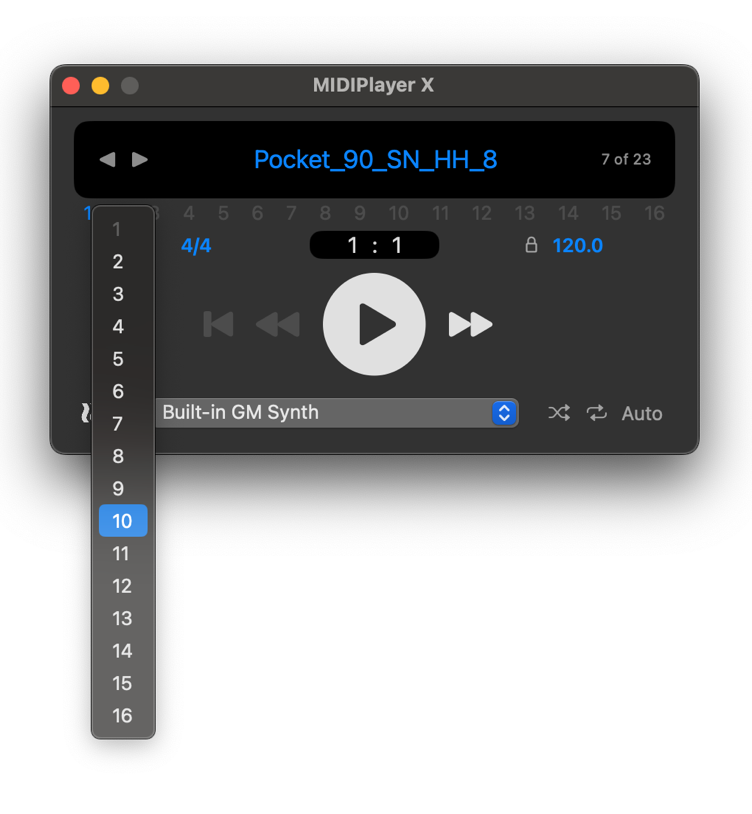

Save Customized MIDI Files
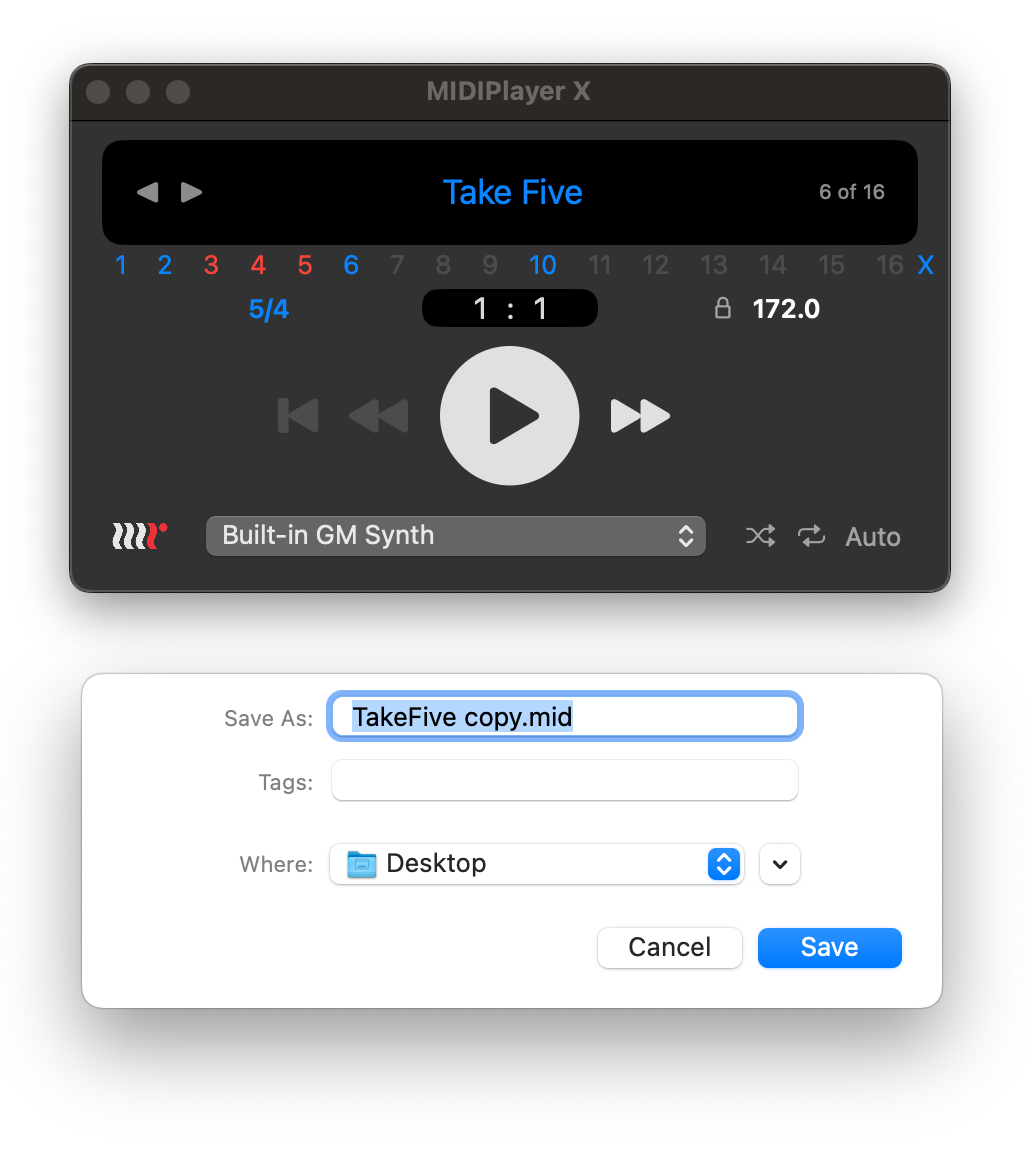

Save As… (shift + command-S)
Use the File>Save As…menu item to create a new copy of your MIDI file, including any changes you’ve made to:
- tempo
- muted channels
- rechannelized channels
Note: Standard MIDI Files do not normally contain any concept of muted tracks / channels. However, MIDIPlayer X will save any channels you have muted, and reload them as muted when reloaded into MIDIPlayer X.
Reveal a File Location
Show in Finder (option-F)
Use File>Show in Finder to open the current file’s enclosing folder in a Finder window.
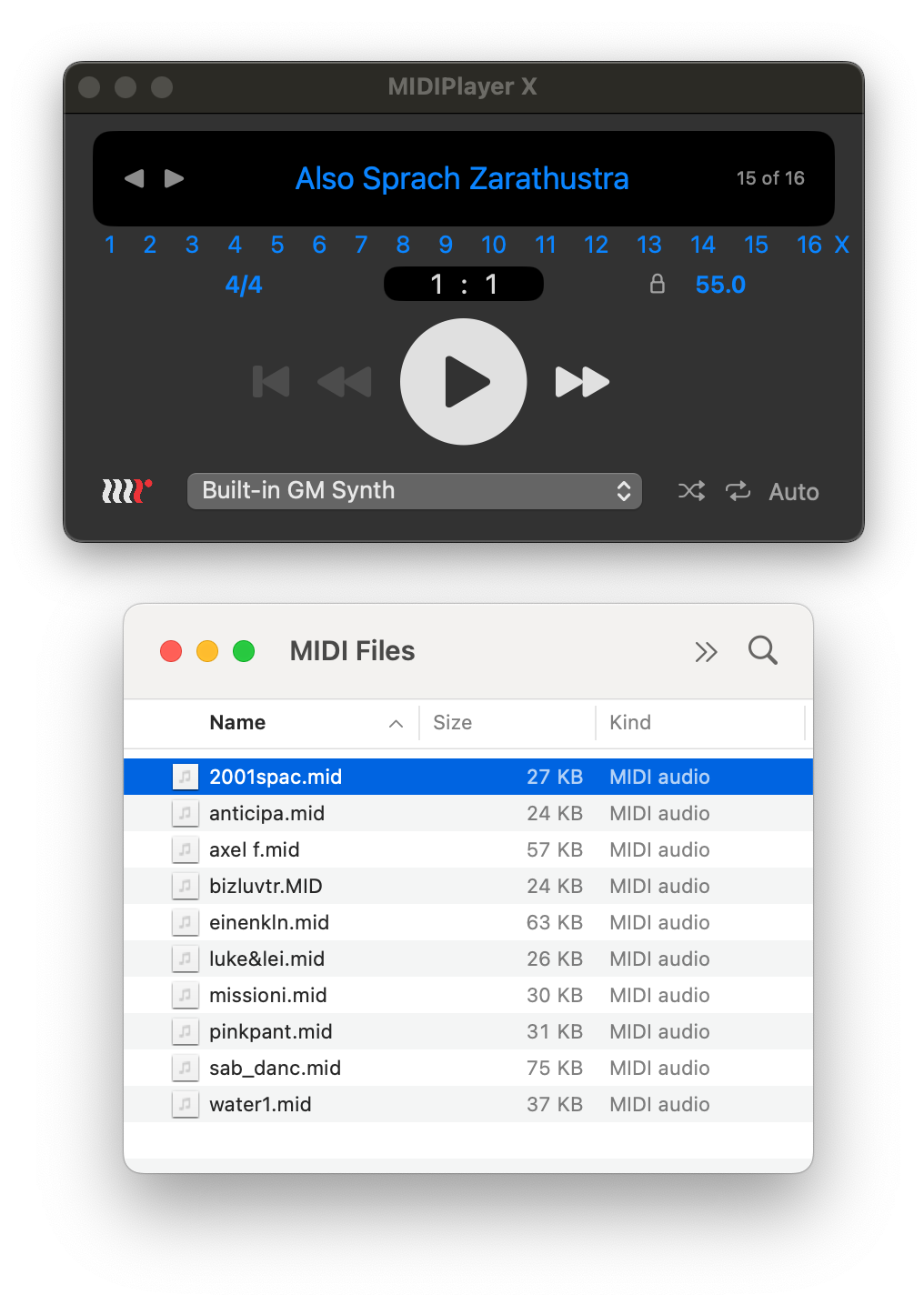

Drag Files Out
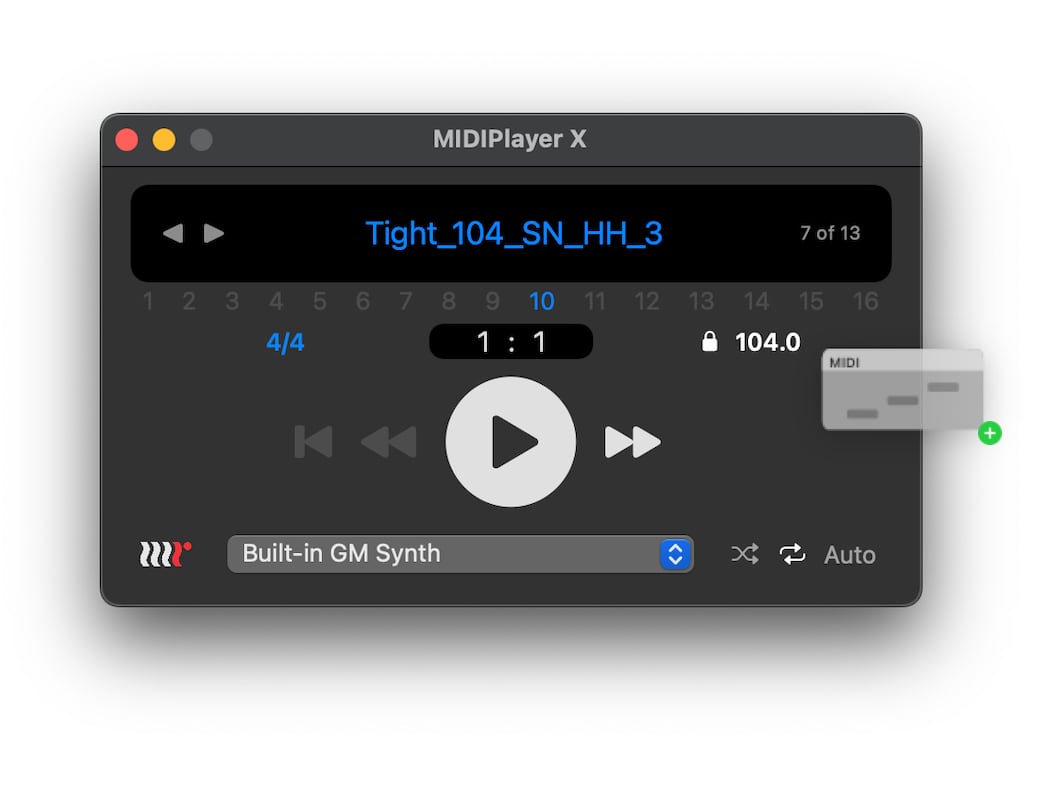

You can drag the current file out of MIDIPlayer X, to drop into your DAW or to a new location in Finder.
To drag out, click and drag most anywhere in MIDIPlayer X’s window, except:
- the black header view
- other clickable controls or buttons, such as the Counter, Output Menu, channel buttons, transport controls, etc.
Note: When dragging out to the Finder, be aware that dragging from MIDIPlayer X is just like dragging files in the Finder – by default, the Finder will MOVE the original file. Hold Option while dragging if you prefer to COPY the file.
Note: to cancel a drag out, press the Esc key anytime before dropping.
Tips
You may find it helpful to assign MIDIPlayer X as the default application for MIDI files. This will let you to simply double-click any MIDI file in the Finder to open it in MIDIPlayer X.
To make MIDIPlayer X your default application for all MIDI files:
- From the Finder, Get Info (command-I) on any .mid file.
- In the Info window, under Open With: select MIDIPlayer X.
- Click Change All.
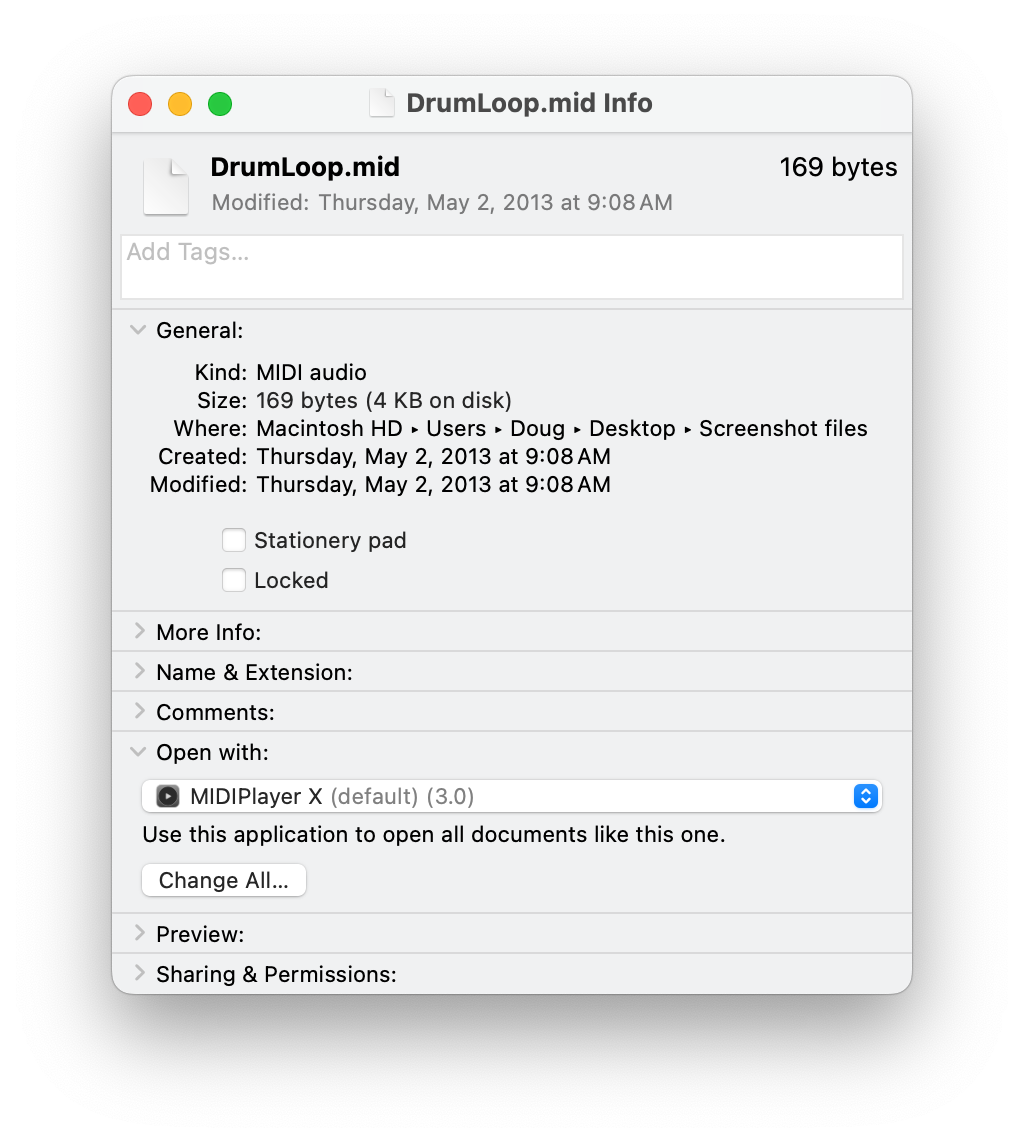

Use MIDIPlayer X’s helpful shortcut anytime you need to view or edit your Mac’s Audio MIDI Setup:
- While MIDIPlayer X is the front app, simply select Window>Audio MIDI Setup.
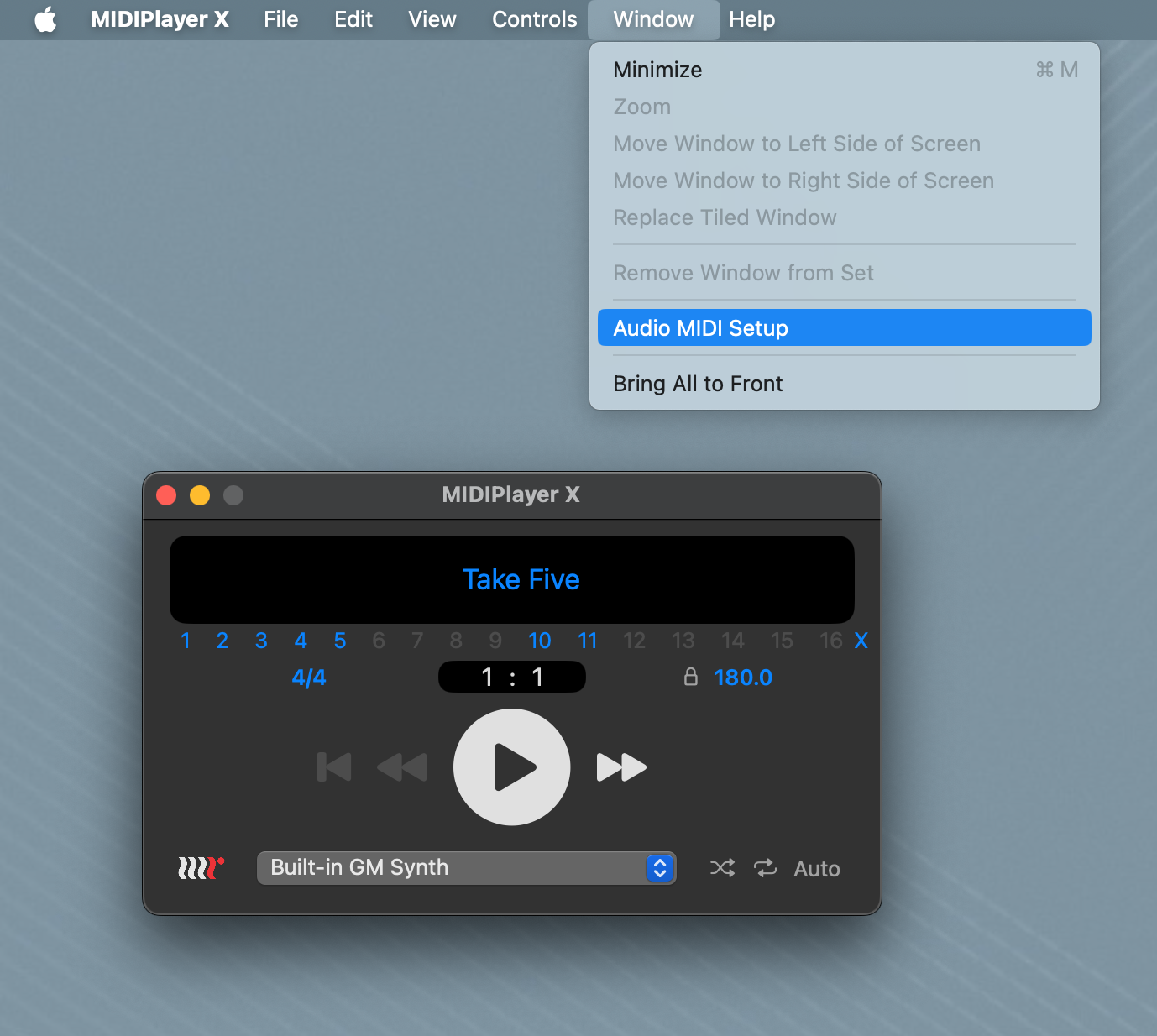

Use multiple MIDIPlayer X features to audition patterns with the Built-in GM Synth kits.
- Turn on Loop.
- Load as many files as you’d like to audition.
- If the files are not on Channel 10, Rechannelize All Files by holding Shift + Control click on the channel button (usuallly Channel 1), then select Channel 10 from the menu.
- To have all files play at the same tempo, turn on Tempo Lock and set the tempo as desired.
- Turn on AutoPlay.
- All files should play to the Rhythm Kit on Channel 10.
- Each file will Loop repeatedly at your desired tempo.
- Use Previous & Next key commands to move easily between files.
- AutoPlay will automatically start each file playing as it is selected.
